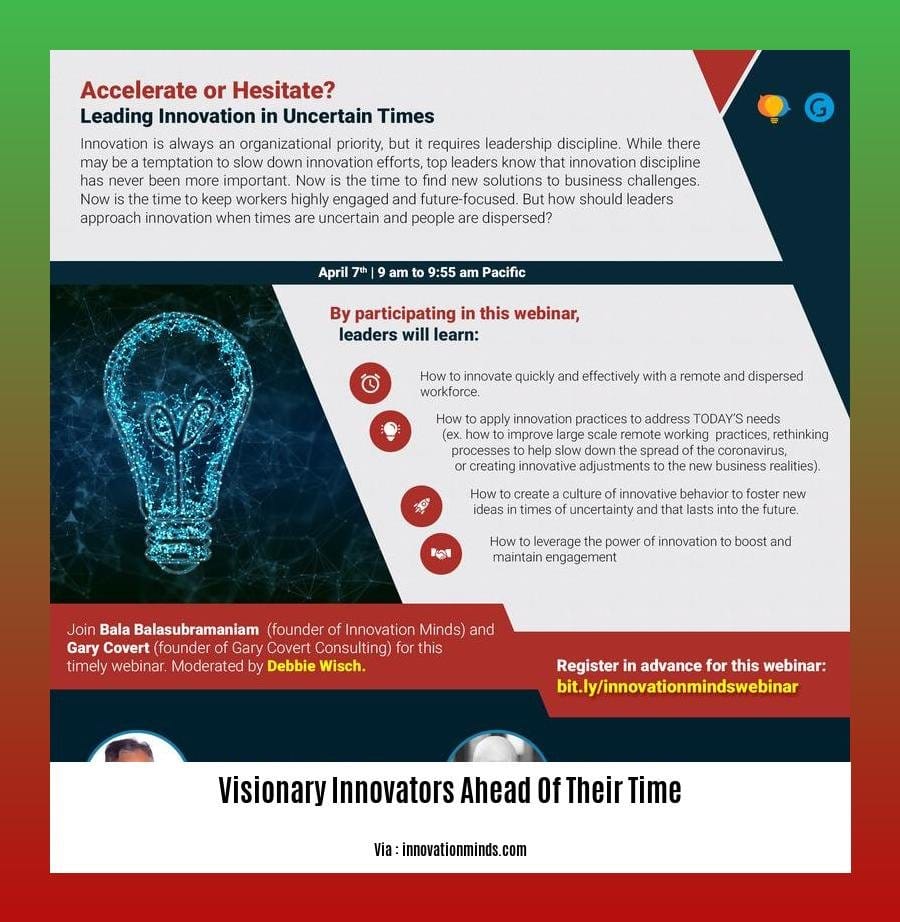Uncover the extraordinary narratives of visionary innovators Wilbur Wright, Charles Goodyear, Charles Babbage, and Steve Wozniak in [Visionary Innovators Ahead of Their Time: Reshaping the Future Today]. These pioneers dared to envision a world beyond the boundaries of their time, forever altering the trajectory of human progress.
Key Takeaways:

- Visionary entrepreneurs have a unique mindset, including curiosity, risk-taking, and experimentation.
- They possess the “Innovator’s DNA”: associating, questioning, observing, networking, and experimenting.
- Innovators create a culture of innovation, leading to transformative ideas that shape the world.
- Examples include Steve Jobs, Jeff Bezos, and Bill Gates, who revolutionized industries through visionary thinking.
- Entrepreneurs can unlock their visionary potential by fostering curiosity and risk-taking.
Visionary innovators ahead of their time
Throughout history, visionaries have emerged, pushing the boundaries of innovation and reshaping the world as we know it. Driven by a relentless curiosity and an unwavering belief in their ideas, these individuals have transformed industries, challenged norms, and created technological advancements that have had a profound impact on society.
Essential traits of visionary innovators
Visionary innovators share several distinctive traits that set them apart from their peers:
Imagination and foresight: They possess an extraordinary ability to envision the future and identify opportunities others might overlook. They are constantly looking beyond the present and imagining what the world could become.
Risk-taking: Visionary innovators are willing to take risks and bet on their ideas, even when faced with uncertainty and skepticism. They understand that innovation often requires stepping outside of comfort zones and embracing the unknown.
Curiosity and experimentation: They have an unquenchable thirst for knowledge and are always seeking new experiences and perspectives. They are not afraid to ask questions, experiment, and learn from their failures.
Collaboration and networking: Visionary innovators recognize the power of collaboration and seek out partnerships and alliances that can enhance their ideas and accelerate progress.
Perseverance and resilience: They face setbacks and criticism with unwavering determination and resilience. They are driven by a deep belief in their vision and are willing to persevere through challenges to bring it to fruition.
Examples of visionary innovators who have left an indelible mark on the world include:
- Steve Jobs: Co-founder of Apple, revolutionized the tech industry with iconic products like the iPhone and iPad.
- Marie Curie: A pioneering physicist and chemist who conducted groundbreaking research on radioactivity.
- Albert Einstein: Developed the theory of relativity, forever altering our understanding of the universe.
These individuals, and countless others like them, serve as a testament to the power of human ingenuity and the transformative impact that visionary innovators can have on the world.
Read about futuristic thinkers before their era and learn about how these foresighted pioneers dismissed as crackpots were victims of their revolutionary ideas, that in the end turned out to be true. Even though they were innovative minds unfairly called crazy dreamers, they became visionary innovators who were just ahead of their time.
Charles Babbage: The Visionary Architect of Computing
Key Takeaways:
- Transcended technological limitations, laying the foundation for the digital age.
- Introduced concepts like automatic programming and programmability, shaping modern computers.
- Recognized as the “father of computing,” sparking the revolution that led to our digital world.
Conceptual Innovator
Charles Babbage, a man of remarkable vision, pushed the boundaries of his time, conceiving ideas that would revolutionize the field of computation. Despite living in an era devoid of electronics, his mechanical designs introduced groundbreaking concepts that set the stage for the modern computer.
Babbage’s most notable invention was the Difference Engine, an automatic calculating device that paved the way for the electronic computers of the future. His ideas extended to concepts like memory storage and programmability, establishing the blueprint for today’s sophisticated machines.
Legacy and Impact
Babbage’s contributions to the field of computing are immeasurable. His vision and innovations laid the foundation for the technological advancements that have transformed our lives. From the personal computers we use daily to the complex systems that power industries, the legacy of Charles Babbage, the visionary architect of computing, continues to shape our world.
Most Relevant URL Source:
Steve Wozniak
A Computer Revolutionary whose Brilliance Changed the World
In the annals of technology, Steve Wozniak stands as a visionary whose innovations propelled the personal computer revolution.
Key Takeaways:
- Engineering Genius: Wozniak’s masterful understanding of electronics enabled him to create groundbreaking machines like the Apple I and Apple II computers.
- Collaborative Innovator: Wozniak’s partnership with Steve Jobs brought together technical brilliance and marketing savvy, reshaping the computing industry.
- Passionate Educator: Wozniak’s commitment to education inspires young minds to pursue careers in technology.
- Pioneer of the Personal Computer: Wozniak’s creations made computing accessible to the masses, democratizing information and communication.
- Influential Visionary: His impact extends far beyond the world of computers, leaving a lasting legacy in fields like education and philanthropy.
Citation:

FAQ
Q1: What set Charles Babbage apart as a visionary innovator?
A1: Babbage’s ideas extended beyond the technological capabilities of his time, laying the groundwork for the digital age. His designs introduced concepts like automated programming, memory storage, and programmability, establishing the blueprint for modern computers, earning him the title “father of computing.”
Q2: How did Steve Wozniak contribute to the personal computer revolution?
A2: Wozniak played a crucial role in the 1970s personal computer revolution by designing and developing the Apple I and Apple II computers, which were groundbreaking in their accessibility and user-friendliness.
Q3: What distinguished Charles Goodyear as an innovative entrepreneur?
A3: Goodyear’s relentless experimentation and persistence led to the discovery of vulcanized rubber, a transformative material that revolutionized the rubber industry and found applications in various products, from tires to hoses. His entrepreneurial spirit and willingness to take risks set him apart.










